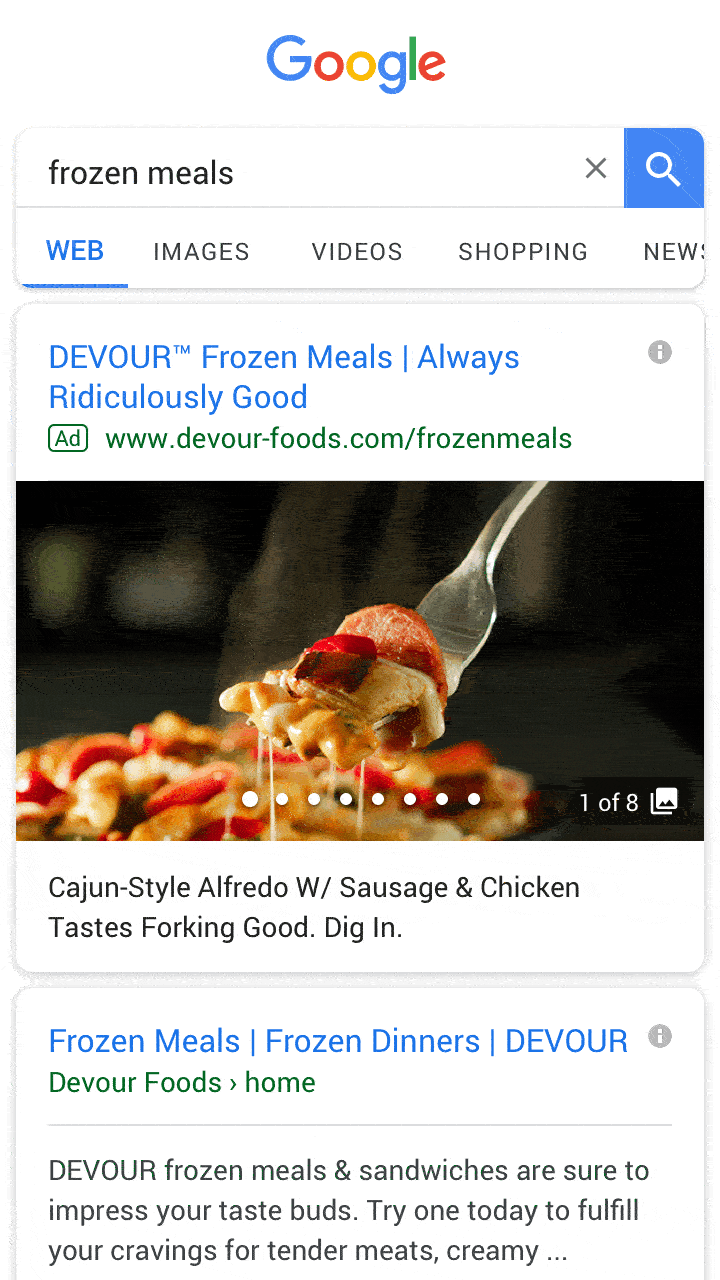Google’s giant gallery ads for search are coming: What they are and how you’ll pay for them
Advertisers can feature up to eight images in gallery ads, Google's new mobile search ad format.
Many of the announcements to come out of Google Marketing Live this year enable advertising across multiple Google properties. One of the few specifically search-centric announcements is the arrival of gallery ads.
Google has been testing gallery ads for a few months — we first reported on them in February. They will be rolling out globally to all advertisers later this year. “By combining search intent with a more interactive visual format, gallery ads make it easier for you to communicate what your brand has to offer,” Prabhakar Raghavan, SVP of Google Ads and Commerce said in the announcement.
[See our roundup of Google Marketing Live 2019 announcements here.]
Here’s a look at a gallery ad from frozen meal brand Devour showing some of products, which are sold through retail partners, not direct to consumers.
What are they? What distinguishes gallery ads is the large swipable carousel of images. “Think of it as generalizing the auto ad unit,” Andy Miller, who leads strategy for search ads, said, referencing the first incarnation of this format designed specifically for the automotive vertical. Users can swipe through the images or click one to expand the gallery into a vertical view that users can swipe down. A call to action to go to the advertiser’s site appears at the end of the gallery.
To set up a gallery ad, you’ll upload four to eight images, a 70 character description and up to three headlines to test.
Where can they show? For now, these ads are only eligible to show in the top spot in Google search results. And only on mobile. Miller said Google will experiment with showing them on desktop and in other Google products.
How do you use them? There is no special campaign type, this is strictly a new ad format. That means they are meant to run in your search campaign ad groups along with text ads.
Gallery ads compete in the same auction against other text ads.
How are they charged? Advertisers get charged for gallery ad interactions in one of two ways. Either on a cost-per-click basis when a user clicks on the headline to go to the advertiser’s website — just like a normal text ad. Or after the user swipes through three images in the gallery. Note, as we mentioned above, the minimum number of images you’ll need to upload is four.
Why should you care? Google knows images drive engagement — hello, Shopping ads — but past tests such as image extensions and big brand banners never panned out. With automotive ads as proof of concept, Google’s tests of this format for other verticals over the past several months appear to have indicate image-heavy text ads can work in search results.
It also highlights the evolution in thinking about search as more than a vehicle for last-click conversion. Advertisers can use gallery ads can be used in several ways — tell a brand story, introduce a product line, etc.
Google said that, on average, ad groups with one or more gallery ad have up to 25% more interactions—paid clicks or swipes—at the absolute top of the mobile Search results page.
Asked how they perform from a conversion standpoint, Miller said, you may not see direct conversions from this ad format but that they can drive non-click conversions or assist conversions further down the customer journey. He noted that ad extensions will be coming, though exactly which ones remains to be determined.
Understanding that they only display in the top ad position in the search results and compete against other text ad formats in an ad group — won’t Google’s quality score calculation, which factors estimated CTR, favor gallery ads over text ads in an ad group? Miller said that might happen, but that they are seeing these ads show on broad queries that haven’t been monetized before, so by including a gallery ad in your ad group you’ll be eligible to compete in more auctions than you would otherwise.
Contributing authors are invited to create content for Search Engine Land and are chosen for their expertise and contribution to the search community. Our contributors work under the oversight of the editorial staff and contributions are checked for quality and relevance to our readers. The opinions they express are their own.
Related stories
New on Search Engine Land
